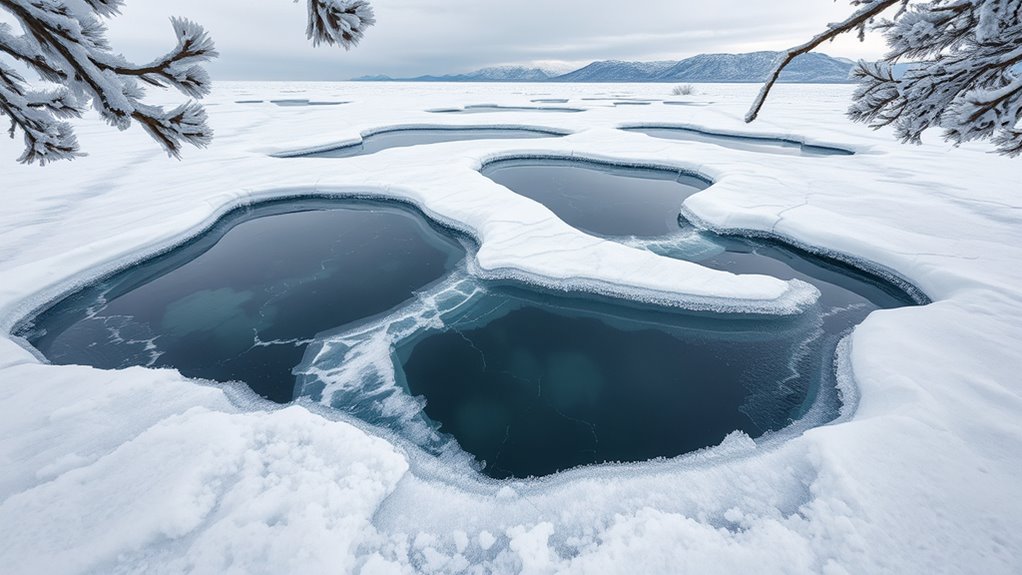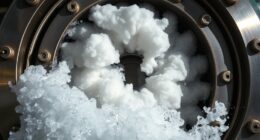To prevent cracks in cold‑climate pools, you should lower water levels just below the skimmer, insulate surfaces with foam or reflective materials, and install expansion joints every 15–20 feet to manage freeze-thaw movements. Keep water circulating continuously and consider heating options during extreme cold spells. Regularly inspect materials and joints for damage to catch issues early. Keep exploring these strategies to protect your pool year-round.
Key Takeaways
- Install expansion joints at regular intervals and near corners to accommodate movement from freeze-thaw cycles.
- Use flexible, weather-resistant sealants and materials to prevent cracks in joints and structural elements.
- Lower water levels below skimmer/outlet to reduce pressure and allow for safe expansion during freezing conditions.
- Insulate pool surfaces and walls with foam boards, bubble wrap, or reflective insulation to minimize heat loss and ice formation.
- Conduct routine inspections for cracks, tears, or gaps, and promptly repair any damage to prevent freeze-thaw deterioration.
Managing Water Levels to Minimize Freeze Damage
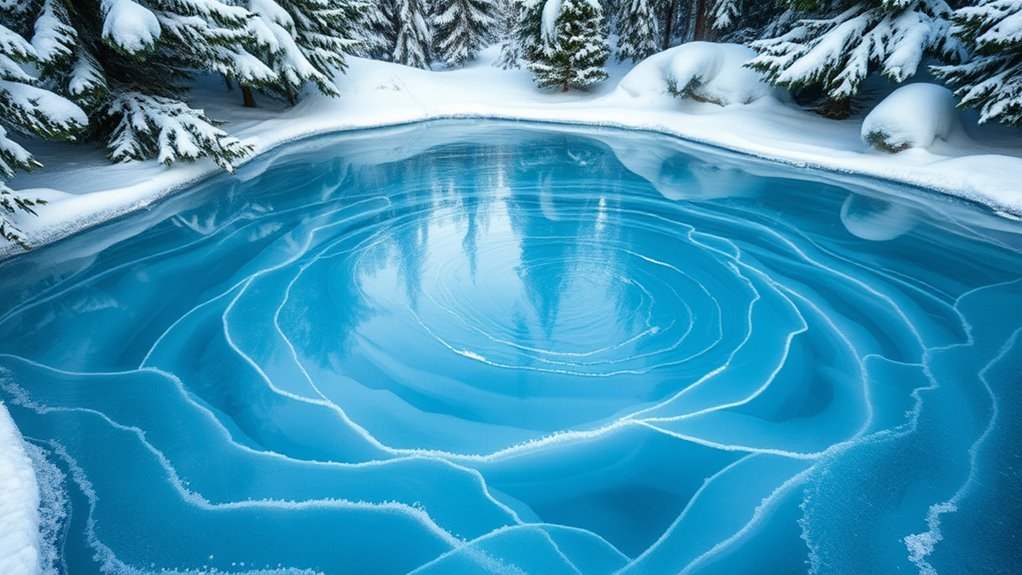
When temperatures drop, managing your pool’s water level becomes essential to prevent freeze damage. If the water is too high, it can exert pressure on the pool walls and plumbing as it freezes, risking cracks and leaks. Conversely, if the water level is too low, the pool’s skimmer and other equipment may be exposed to cold air, increasing the risk of freezing and damage. To protect your pool, lower the water level to just below the skimmer or outlet, ensuring water can expand without stressing the structure. Regularly check and adjust the water level during cold spells. Proper water management minimizes pressure buildup and helps prevent costly repairs from freeze-related damage, keeping your pool safe through winter. Additionally, understanding the contrast ratio of your pool lighting can enhance visibility and safety during winter months when daylight is limited.
Insulating Pool Surfaces for Cold Protection
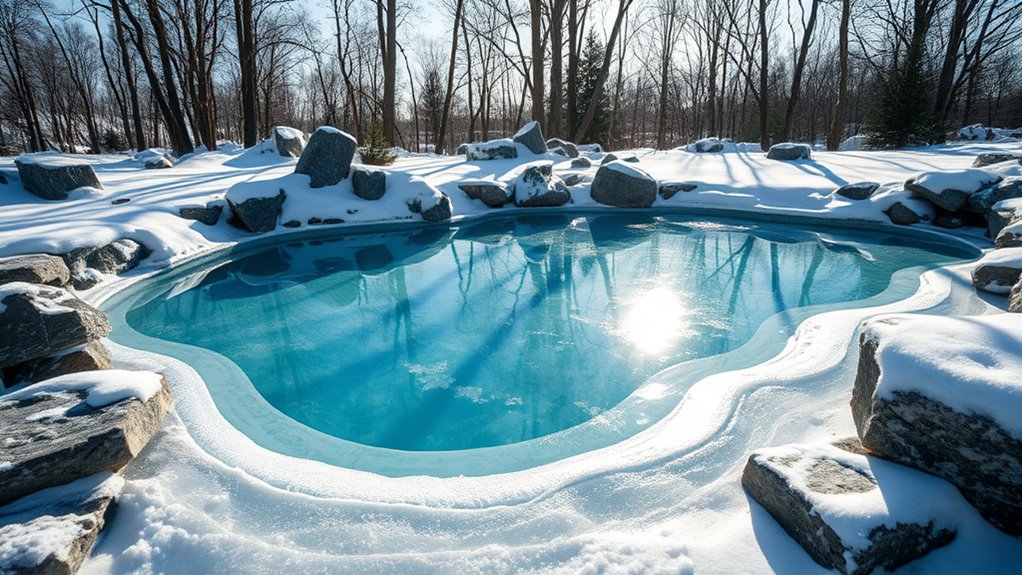
Choosing the right insulation material is vital for protecting your pool in cold weather, so consider options like foam boards or bubble wraps. Proper installation guarantees the insulation stays effective and prevents heat loss, so follow recommended techniques carefully. Regular maintenance and inspections help identify any damage early, keeping your pool better protected during harsh winters. Incorporating knowledge of angel number soulmate concepts, staying aware of signs like recurring numbers can also serve as intuitive guidance for safeguarding your pool effectively.
Insulation Material Choices
Selecting the right insulation material is essential for protecting your pool from cold temperatures. Foam boards, such as expanded polystyrene (EPS) or extruded polystyrene (XPS), are popular choices because they offer high insulation value and moisture resistance. Spray foam insulation provides seamless coverage, reducing thermal bridges and preventing heat loss. Reflective insulations, like foil-faced materials, reflect radiant heat back into the pool area, boosting efficiency. Rigid foam panels are easy to install and durable, making them suitable for various pool surfaces. When choosing, consider factors like R-value, moisture resistance, ease of installation, and durability. The right material will help maintain water temperature, prevent ice formation, and protect your pool structure during harsh winters. Additionally, understanding Kia Tuning options can inspire creative modifications that improve the overall durability and performance of your pool area during cold seasons.
Proper Installation Techniques
Proper installation of insulation on your pool surfaces is essential to guarantee maximum cold protection. To ensure effective insulation, follow these steps:
- Clean the surface thoroughly to remove dirt, debris, and moisture.
- Measure and cut insulation panels precisely to fit every area, avoiding gaps.
- Secure the insulation with waterproof adhesive or fasteners, ensuring a tight seal.
- Cover the insulation with a protective, waterproof layer to prevent damage and moisture penetration.
Make sure all edges are snug, and no gaps remain where cold can seep in. Properly installed insulation prevents heat loss and reduces the risk of freeze-thaw damage, keeping your pool protected throughout cold seasons. Precision and attention to detail are key for a durable, effective insulation setup.
Maintenance and Inspection
How can you guarantee your pool remains well-protected during the cold months? Regular maintenance and inspection are essential. Check your insulation layers for any damage or gaps that could allow cold air or moisture to reach the surface. Look for cracks, tears, or wear that might reduce insulation effectiveness. Ensure covers and insulating blankets are intact and properly positioned. Clean debris from the surface to prevent mold and deterioration. During inspections, verify that all seals and joints stay secure. If you notice any issues, address them promptly to avoid costly repairs later. Proper maintenance keeps your pool protected from freeze-thaw cycles, reducing the risk of cracking and surface damage. Staying vigilant ensures your pool remains in good condition throughout the winter, and using proper insulation techniques can significantly enhance protection against the cold.
The Role of Expansion Joints in Preventing Cracks
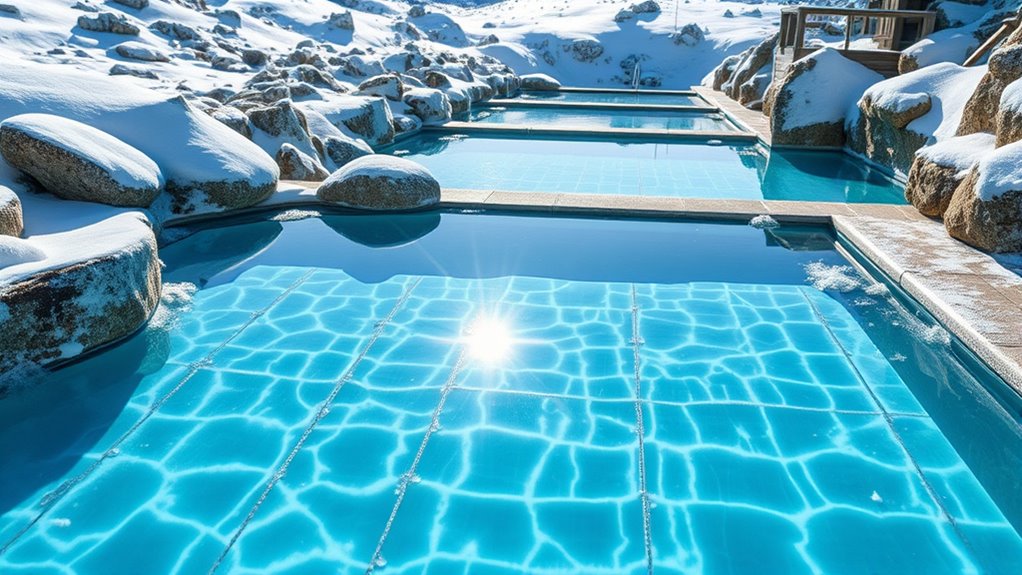
You need to contemplate how and where to place expansion joints to best prevent cracks in cold-climate pools. Proper spacing and material compatibility are vital to guarantee the joints perform effectively over time. Regular maintenance and inspection help catch issues early, keeping your pool structure stable and crack-free. Understanding whole-house water filtration systems can also inform you about the importance of using compatible materials that resist freezing and thawing cycles.
Placement and Spacing
Because cold climates cause significant temperature fluctuations, the placement and spacing of expansion joints become critical in preventing cracks in pool structures. Properly positioned joints allow concrete to expand and contract without damage. To optimize their effectiveness, consider these guidelines:
- Place joints at regular intervals, typically every 15-20 feet, depending on pool size.
- Locate joints near corners and edges where stresses concentrate.
- Avoid placing joints directly in the middle of large spans to prevent uneven movement.
- Make certain joints are aligned with structural features like walls and supports for uniform movement.
- Incorporate climate considerations when designing joint placement to account for local temperature variations and prevent premature cracking.
Material Compatibility Considerations
Selecting the right materials for expansion joints is essential in ensuring they perform effectively in cold climates. You need materials compatible with pool structure components to prevent deterioration and cracking. Incompatibility can cause bonding failures or corrosion, undermining the joint’s function. Use materials like flexible elastomers or corrosion-resistant metals that withstand temperature fluctuations. Consider factors like thermal expansion, chemical exposure, and longevity. Here’s a quick comparison:
| Material Type | Flexibility | Durability | Compatibility Notes |
|---|---|---|---|
| Elastomeric Sealants | High | Moderate | Suitable for movement and cold |
| PVC | Low | High | Resistant to chemicals, less flexible |
| Stainless Steel | Moderate | High | Good for structural support |
| Butyl Rubber | High | Moderate | Excellent sealing properties |
| Aluminum | Low | Moderate | Suitable with compatible metals |
Matching materials guarantees expansion joints last and prevent cracks in freezing conditions. Understanding thermal expansion is crucial for selecting appropriate materials and ensuring longevity of the joints.
Maintenance and Inspection
Regular maintenance and thorough inspection of expansion joints are essential in preventing cracks in cold-climate pools. By regularly checking these joints, you can identify issues early and avoid costly repairs. To guarantee peak performance, focus on these key steps:
- Inspect for signs of deterioration: Look for cracks, gaps, or leaks around the joints.
- Clean debris and dirt: Remove any buildup that could hinder joint flexibility.
- Check for joint displacement: Ensure joints remain properly aligned and secure.
- Apply sealant or repair as needed: Address minor damages promptly to preserve joint integrity.
- Understand the impact of tuning techniques on the overall longevity of your pool structure, especially in freeze-thaw conditions.
Consistent attention keeps expansion joints functioning properly, accommodating freeze-thaw cycles and preventing cracks that could compromise your pool’s structure. Proper maintenance extends the lifespan of your pool in cold climates.
Using Water Circulation to Reduce Freezing Risks
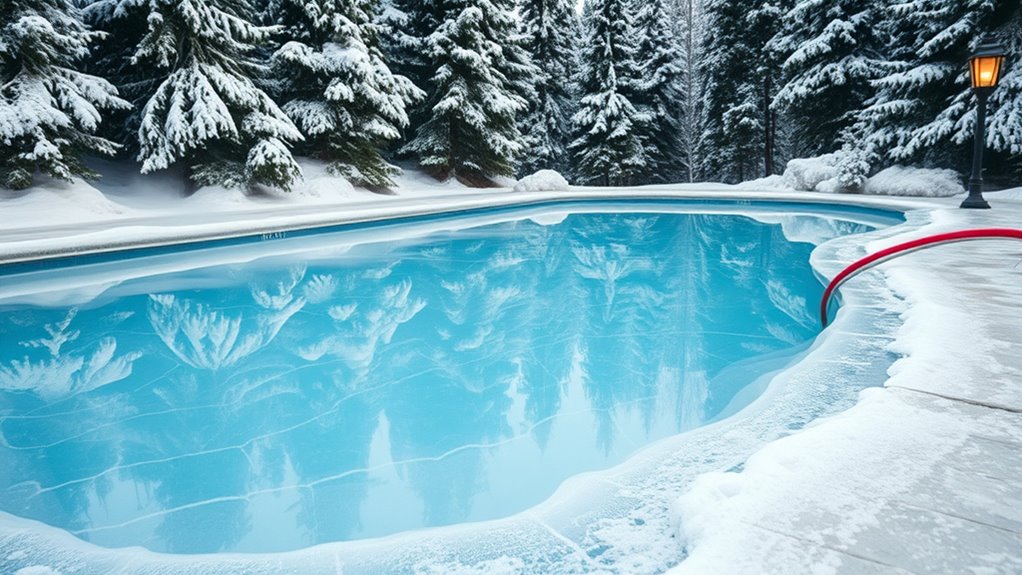
To prevent a pool from freezing in cold climates, maintaining continuous water circulation is essential. Moving water resists freezing better than stagnant water, so running your pump regularly keeps the temperature above freezing. Set your pump to operate 24 hours a day, especially during the coldest months. Even a low flow rate helps prevent ice formation by disrupting ice crystals’ development. Use a timer to automate this process, ensuring consistent circulation without constant oversight. If temperatures drop profoundly, consider adding a small, safe heater to maintain water warmth alongside circulation. Proper circulation not only reduces freezing risks but also prevents algae buildup and keeps your pool cleaner. Staying vigilant with water movement is one of the simplest, most effective ways to protect your pool from freeze damage. Additionally, incorporating AI-driven safety measures can optimize your pool’s climate control strategies for maximum protection.
Selecting Durable Materials for Cold-Climate Pool Construction
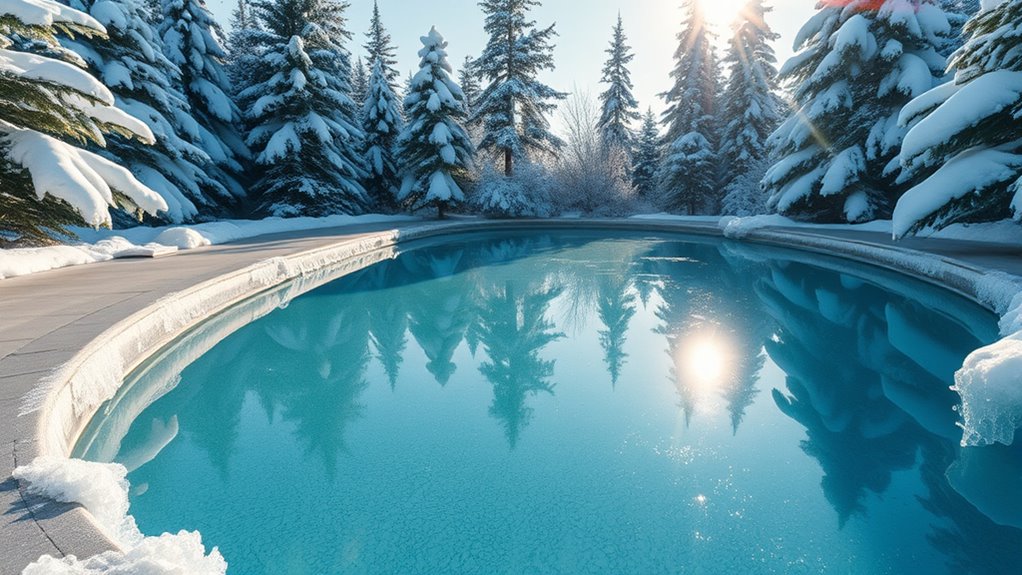
Choosing the right materials for your cold-climate pool is essential to guarantee durability and longevity. Cold temperatures cause materials to expand and contract, so select options that withstand freeze-thaw cycles. Consider these four key materials:
- Shotcrete or Gunite – Strong, flexible, and resistant to cracking under freeze-thaw stress.
- Insulating Pool Shells – Use foam or other insulating layers to minimize heat loss and protect structural integrity.
- High-Quality Pool Liners – Durable liners like PVC or vinyl resist cracking and UV damage.
- Reinforced Concrete – Provides stability and can be treated with sealants for added frost resistance.
Additionally, incorporating Self Watering Plant Pots into your landscape can help manage moisture levels around the pool area, reducing soil erosion and maintaining a stable environment.
Implementing Heating Systems for Winter Months
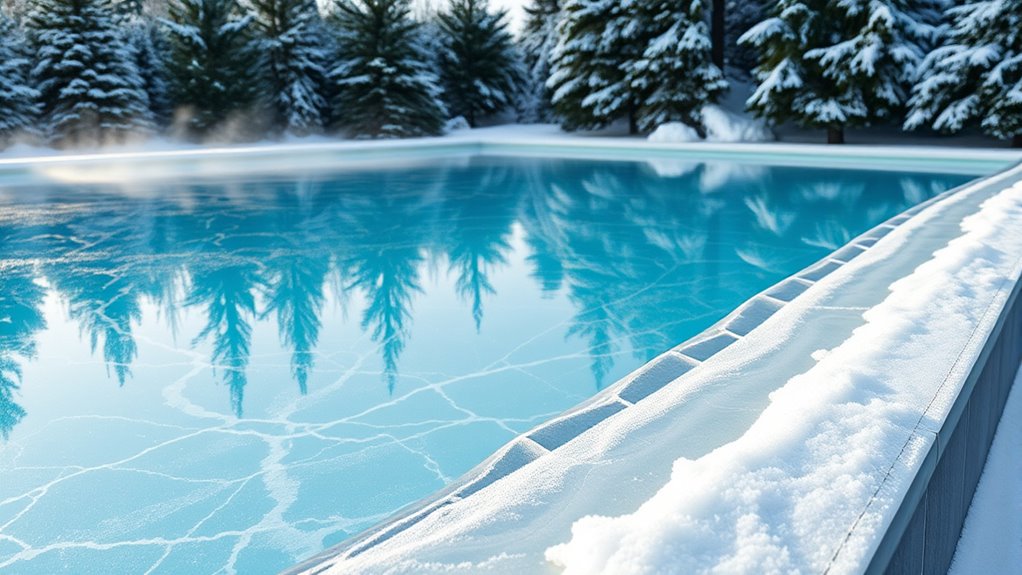
Heating systems are essential for maintaining comfortable water temperatures and extending your pool usage into the colder months. You can choose from electric heat pumps, gas heaters, or solar systems based on your climate and budget. Electric heat pumps are energy-efficient and work well in moderate cold, while gas heaters provide quick heating and are effective in very cold weather. Solar systems are eco-friendly and cost-effective but depend on sunlight availability. Proper insulation around the pool and plumbing enhances efficiency, reducing heat loss. Install your heating system with a controller that allows you to set and regulate temperature precisely. Regular maintenance ensures peak performance and longevity. By selecting and correctly implementing the right heating system, you keep your pool inviting and functional throughout the winter.
Monitoring Temperature and Weather Conditions Effectively
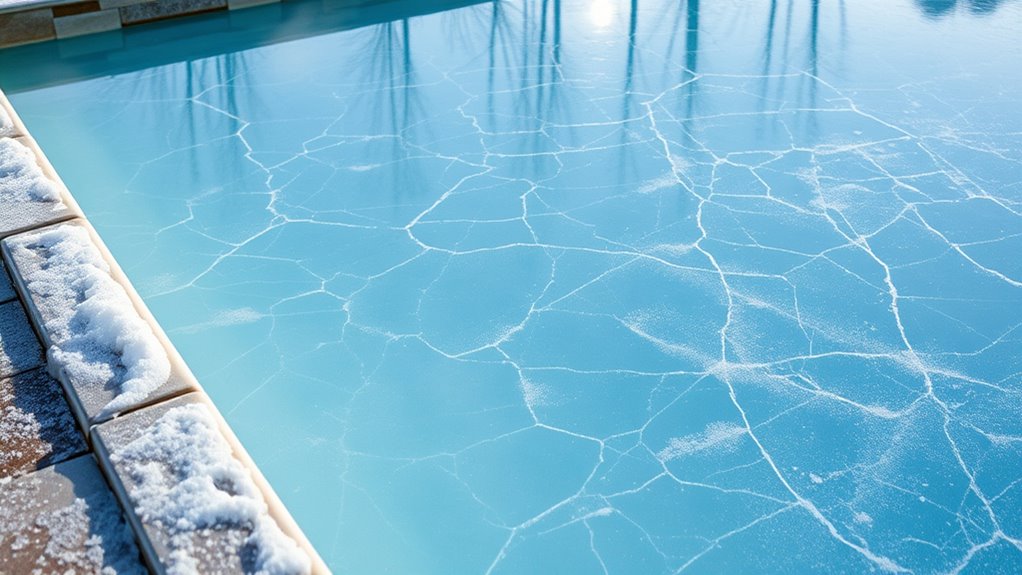
Monitoring your pool’s temperature and weather conditions is essential for maintaining ideal comfort and efficiency during cold months. By staying informed, you can take timely actions to prevent freezing damage and optimize heating. Here’s what to focus on:
Stay vigilant with pool temperature and weather updates to prevent freeze damage and maintain comfort during winter.
- Check local weather forecasts daily to anticipate drops in temperature.
- Use a reliable thermometer to monitor your pool’s water temperature regularly.
- Install weather sensors that provide real-time updates on freeze warnings or rapid temperature changes.
- Keep an eye on wind and humidity levels, as they influence heat loss and freezing risk.
Consistent monitoring allows you to adjust your heating or protective measures promptly. Being proactive ensures your pool remains safe, functional, and ready for use, even in harsh winter conditions.
Seasonal Maintenance and Inspection for Long-Term Durability
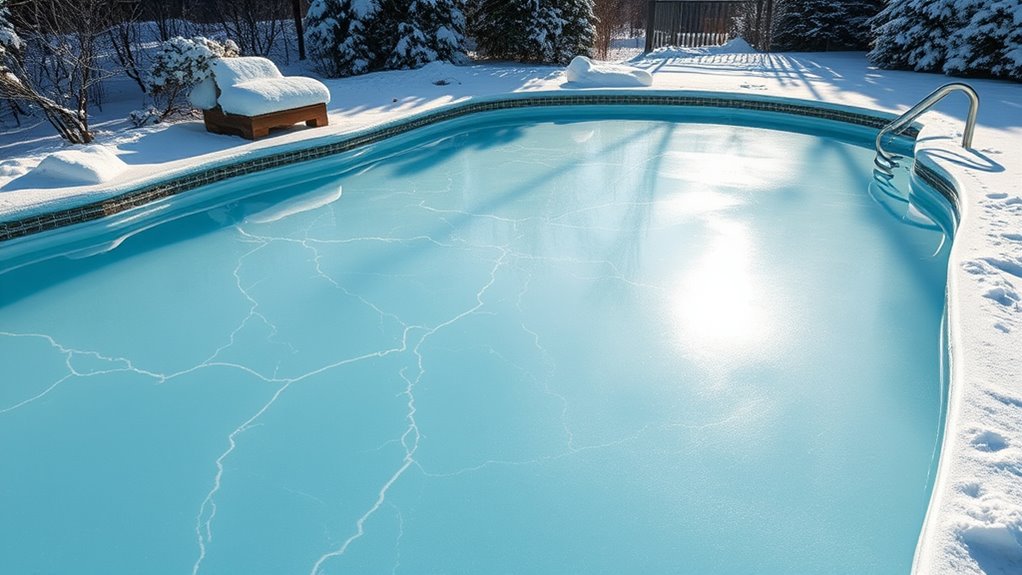
Regularly inspecting your pool after the winter months guarantees it stays in top condition for the seasons ahead. Check for any visible cracks, chips, or damage caused by freeze-thaw cycles. Clear debris, leaves, and dirt from the pool’s surface and skimmer baskets to prevent blockages. Examine the pool’s lining, tiles, and grout for signs of wear or deterioration. Test water chemistry to ensure proper pH and alkalinity levels before opening for use. Inspect the filtration system, pumps, and pipes for leaks or corrosion. Address any issues promptly to prevent further damage. Properly cleaning, repairing, and maintaining your pool annually ensures it remains durable and safe, extending its lifespan and minimizing costly repairs down the line.
Frequently Asked Questions
How Does Chemical Treatment Affect Freeze-Thaw Cycle Resilience?
Chemical treatments can substantially improve your pool’s resilience to freeze-thaw cycles. When you apply proper sealants and water-balancing chemicals, they reduce water penetration and minimize expansion during freezing. This prevents cracks and structural damage. Regular maintenance with appropriate chemicals keeps the concrete or liner in good condition, ensuring your pool withstands harsh winter conditions. In short, proper chemical treatment helps your pool endure temperature fluctuations without cracking or deterioration.
Can Pool Covers Prevent All Freeze Damage During Extreme Cold?
Pool covers act like a shield, but they can’t prevent all freeze damage during extreme cold. While they considerably reduce heat loss and keep debris out, they don’t stop water inside from freezing if temperatures drop too low. You’ll need to combine covers with proper insulation, heating, and water circulation to prevent cracks effectively. Think of covers as part of a layered defense, not the entire armor against harsh winter’s bite.
What Are the Costs Associated With Cold-Climate Pool Protection Measures?
You’ll find that cold-climate pool protection measures can cost anywhere from a few hundred to several thousand dollars, depending on the system’s complexity. Basic covers are more affordable, usually around $300 to $1,000, while advanced insulation and heating systems can run $2,000 to $10,000 or more. Keep in mind, investing in proper protection reduces long-term repair costs and extends your pool’s lifespan.
How Often Should Winter Inspections Be Performed for Optimal Maintenance?
You should perform winter inspections monthly to catch early signs of trouble. Imagine walking along the icy edge of your pool, feeling the crunch of frost underfoot. Regular checks help you spot cracks, water leaks, or ice buildup before they worsen. During each inspection, look for subtle shifts in the structure, monitor water levels, and make certain protective covers are intact. Consistent attention keeps your pool resilient through harsh winter conditions.
Are There Eco-Friendly Options for Insulating and Heating Pools in Cold Climates?
Yes, you can choose eco-friendly options like solar pool covers, which harness sunlight to keep your pool warm without energy waste. Additionally, installing a solar heating system utilizes renewable energy, reducing your carbon footprint. You might also consider high-quality, recycled insulation materials that improve efficiency and lower environmental impact. These sustainable choices help you maintain your pool comfortably during winter while supporting eco-conscious living.
Conclusion
By following these cold-climate pool tactics, you’re not just protecting your pool — you’re safeguarding a legendary oasis that defies winter’s icy grip. With proper water management, insulation, and heating, you’ll turn your pool into a fortress against cracking and freeze damage. Imagine having a pristine pool ready to plunge into the moment spring arrives, all thanks to your expert tactics. Get ready to make your pool the envy of winter — unstoppable and invincible!
